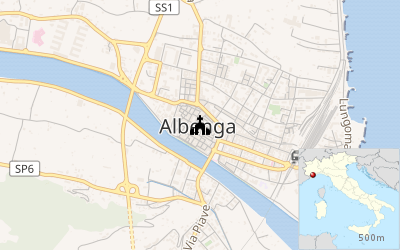Albenga Cathedral
Albenga Cathedral (Italian: Cattedrale di San Michele Arcangelo, Duomo di Albenga) is a Roman Catholic cathedral dedicated to Saint Michael in the city of Albenga, in the province of Savona and the region of Liguria, Italy. It is the seat of the Diocese of Albenga-Imperia.[1]

A church has occupied the site since the turn of the 4th to the 5th century, but the present structure is medieval, built in about 1100, with a major rebuilding in the second half of the 12th century, and another in 1582. A restoration project in the 1970s largely returned the building to the medieval structure. The campanile was rebuilt in its present form in the 1390s.
The relics of Saint Veranus (San Verano), who was instrumental in the Christianisation of Albenga in the 6th century, are preserved in a shrine.
The cathedral interior is well stocked with sculptures and works of art. The 19th century ceiling frescos are by Maurizio and Tommaso Carrega. Other frescos, particularly those in the apse, are of the 15th century. The right hand nave contains a fresco by the artist Il Pancalino of Saint Clare and two donors, and of the Crucifixion with Saints Anthony the Great and John the Evangelist, with the bishop of Albenga. The altarpiece on the high altar depicts Saint Veranus, Saint Michael and John the Baptist.
The cathedral also owns two paintings of the late 14th century by Luca Baudo of Saint Eligius and Saint Ampelius; a painting of the "Miracle of San Verano" by Giovanni Lanfranco; and a Madonna and Child with saints by Orazio de Ferrari (the last two are not publicly displayed for security reasons).
History
| Location of Albenga Cathedral |
 |
Located in the center of the medieval city of Albenga, the foundation of the original building of worship dating back to the reconstruction of the city. Which took place through the work of Costanzo between the end of 4th and early 5th centuries, in the center of the Roman city. It stands on the site with the exact dimensions of the early Christian one. Its rebuilding occurred around 1100, on the ruins of the early Christian church, and again in the second half of the 20th century.
According to tradition, in the way that leads Albenga to Alassio, there was a snake that killed everyone. The people made a procession praying Archangel Michael to kill the snake. During the night he saw a glow coming from the sky and head towards a point on the road, people noticed quickly, and found the snake killed.
The first plant
An early study of ancient plant early Christian was undertaken between 1964 and 1967 where he ascertained that the structure was a basilica and very large. The archaeological excavation are were discovered the foundations of two column that enriched the 'altar. Will be with the invasion in the 643 of Lombard king Rotari in the territories of Liguria that the church was reduced to one aisle Central.
Thanks to the division of Liguria in Brands, which allowed a greater importance for Albenga and his diocese, the plant was rebuilt in the 11th century in forms to proto-Romanesque nave and crypt. The steps of this reconstruction are still visible in the lower wall of the facade.
Structure
The cathedral is today divided into three aisles with the division in column and pillars original supporting arches ogival rebuilt. Interventions of Nino Lamboglia also allowed the deletion of the elements baroque from sanctuary, now raised to liturgical requirements and to make more visible the crypt protoromanic.
The various structural stages in the centuries that followed are clearly visible in the outside facade which shows a remarkable rose and a decoration arches. The adjacent bell tower was rebuilt between 1391 and 1395 by the architect-canonical Serafino Mignano with the help of master builders Oberto and Tommaso Caressia. Considered the most famous example of period Late Gothic, is developed in five rows of mullioned and trifore culminating with a cusp polygonal pinnacles to the four corners.
Images
- Fresco of Saint Clare
- Relics of Saint Veranus
 Frescos of John the Baptist and Saint Sebastian
Frescos of John the Baptist and Saint Sebastian Detail of Saint Sebastian
Detail of Saint Sebastian- The organ
References
Sources and external links
- Diocese of Albenga-Imperia website (in Italian)
- SBAPGE website: Albenga Cathedral (in Italian)
- Provincia Savona website: Cattedrale di San Michele (in Italian)